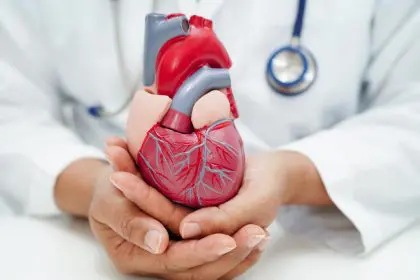A large stomach can often be dismissed as just a cosmetic issue, but it is a health red flag that should not be ignored. Many people associate a bigger belly with overeating or lack of exercise, but it can actually be an indication of poor gut health and potential organ damage. The way our bodies store fat — particularly around the midsection — can tell us a lot about our internal well-being. Understanding these signs can help prevent more serious conditions in the future, from digestive issues to heart disease.
This article will dive into five major health red flags associated with a large stomach and why it’s crucial to pay attention to your body’s signals. By the end, you’ll have a better understanding of how your gut health impacts your overall health and what steps you can take to prevent potential organ damage.
1. Abdominal fat and poor gut health
The size of your stomach is often linked to the health of your gut. The gut — sometimes called the “second brain” — plays a significant role in overall wellness. It not only digests food but also regulates your immune system and affects your mental health. When the gut microbiome — the collection of bacteria and other microorganisms living in your intestines — is out of balance, it can lead to inflammation and poor digestion.
Poor gut health can cause bloating, indigestion and weight gain, particularly around the stomach. When your stomach grows due to these issues, it’s a clear sign that your digestive system isn’t functioning properly. Chronic bloating and discomfort should never be ignored, as they may lead to more serious digestive problems, like irritable bowel syndrome (IBS) or small intestinal bacterial overgrowth (SIBO).
Addressing gut imbalances
Taking proactive steps to restore balance in the gut is key to reducing abdominal size and preventing further health complications. Probiotics, fiber-rich diets and stress management are some initial measures that can promote a healthier gut environment.
2. Visceral fat
Visceral fat is the type of fat stored deep within the abdomen, surrounding vital organs like the liver, pancreas and intestines. While you can’t see or pinch visceral fat, a growing belly often signals its presence. Unlike subcutaneous fat (the kind you can pinch), visceral fat increases the risk of metabolic syndrome, type 2 diabetes and cardiovascular diseases. It is considered one of the most harmful types of fat due to its proximity to important organs.
A large stomach may suggest a high level of visceral fat, which not only affects your appearance but your long-term health. Organ function can become impaired when surrounded by excess fat, leading to conditions like fatty liver disease, which is directly tied to visceral fat buildup.
How to combat visceral fat
Regular exercise, particularly aerobic activities like walking and swimming, can help reduce visceral fat. Additionally, a balanced diet with limited processed foods and sugars plays a crucial role in managing this dangerous fat.
3. Liver damage and belly fat
Another health red flag that a large stomach may indicate is liver damage, particularly non-alcoholic fatty liver disease, or NAFLD. NAFLD occurs when fat builds up in the liver, leading to inflammation and eventually liver damage. This condition is increasingly common in people who carry excess weight around their midsection. The liver plays a critical role in detoxifying the body and metabolizing fats, and when it is overwhelmed by fat, its ability to function is compromised.
Symptoms like fatigue, discomfort in the upper right side of the abdomen and, of course, a large belly are signs that your liver might be struggling to keep up. Ignoring these symptoms can lead to cirrhosis, a severe form of liver damage that is irreversible.
Supporting liver health
Maintaining a healthy liver involves managing weight, reducing alcohol consumption and incorporating liver-friendly foods such as leafy greens, berries and garlic into your diet.
4. Insulin resistance and abdominal obesity
A large stomach can also be an indicator of insulin resistance — a condition where the body’s cells don’t respond properly to insulin — the hormone that regulates blood sugar levels. When this happens, the body stores more fat, especially around the abdominal area. Insulin resistance is a precursor to type 2 diabetes and can increase your risk of heart disease.
Abdominal obesity is a hallmark sign of insulin resistance, as excess fat around the waistline interferes with the body’s ability to use insulin efficiently. This creates a dangerous cycle where more fat is stored in the abdomen, worsening insulin resistance and increasing the risk of diabetes and cardiovascular issues.
Breaking the cycle of insulin resistance
Incorporating more physical activity and choosing a low-glycemic diet can help combat insulin resistance. Reducing the intake of sugary and processed foods is essential to preventing the buildup of abdominal fat and improving insulin sensitivity.
5. Heart disease and an expanding waistline
Perhaps one of the most serious consequences of a large stomach is its connection to heart disease. Numerous studies have linked abdominal obesity with a higher risk of heart attacks, high blood pressure and cholesterol issues. The fat stored in the stomach — particularly visceral fat — produces inflammatory substances that negatively affect heart health. These substances can cause plaque buildup in the arteries, leading to atherosclerosis and, ultimately, heart attacks.
A growing waistline is often an early warning sign that your heart might be at risk. If left unchecked, abdominal obesity can quickly progress into more severe cardiovascular issues, shortening life expectancy and diminishing quality of life.
Protecting your heart
Preventing heart disease starts with monitoring your waist size and taking proactive measures like eating a heart-healthy diet, managing stress and staying physically active. Foods rich in omega-3 fatty acids, whole grains and antioxidants can strengthen heart health and reduce the risk of abdominal fat accumulation.
Listen to what your body is telling you
A large stomach is more than just an aesthetic concern — it’s your body’s way of signaling that something is wrong. Whether it’s poor gut health, liver damage, insulin resistance or heart disease, the risks associated with abdominal fat are far-reaching and serious. Paying attention to these health red flags and taking immediate action can prevent the progression of these conditions.
By adopting a healthy lifestyle, including a balanced diet, regular exercise and stress management, you can reduce belly fat, improve gut health and protect your organs from damage. Remember, your body gives you signals for a reason, and it’s up to you to respond to them before they turn into bigger problems.
This story was created using AI technology.













